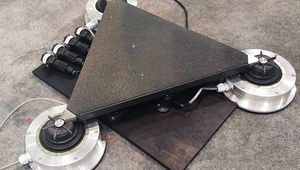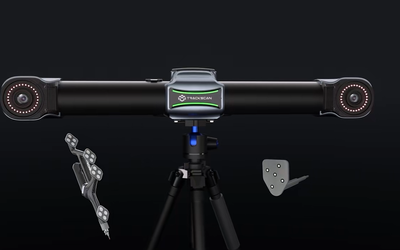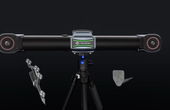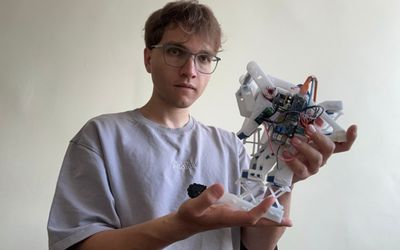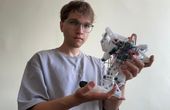Universal Robots' UR3e
A tabletop collaborative robot for light assembly tasks and automated workbench cases.
Technical Specifications
| Payload | 3 kg (6.6 lbs) |
| Reach | 500 mm (19.7 in) |
| Degrees of freedom | 6 rotating joints |
| Programming | 12 inch touchscreen with polyscope graphical user interface |
| Physical | |
| Footprint | Ø 128 mm |
| Materials | Aluminium, Plastic, Steel |
| Tool (end-effector) connector type | M8 | M8 8-pin |
| Cable length robot arm | 6 m (236 in) cable included |
| 12 m (472 in) and high-flex options available. | |
| Weight including cable | 11.2 kg (17.7 lbs) |
| Operating temperature range | 0-50°C |
| Humidity | 90%RH (non-condensing) |
| Performance | |
| Power, Consumption | Maximum Average: 300 W |
| Typical with moderate settings: 100 W | |
| Force Sensing, Tool Flange (Force, x-y-z) | Range: 30.0 N |
| Precision: 2.0 N | |
| Accuracy: 3.5 N | |
| Force Sensing, Tool Flange (Torque, x-y-z) | Range: 10.0 Nm |
| Precision: 0.1 Nm | |
| Accuracy: 0.1 Nm | |
| Movement | |
| Pose Repeatability per ISO 9283 | ± 0.03 mm |
| Axis movement (Working range) | Base: ± 360° |
| Shoulder: ± 360° | |
| Elbow: ± 360° | |
| Wrist 1: ± 360° | |
| Wrist 2: ± 360° | |
| Wrist 3: Infinite | |
| Axis movement (Maximum speed) | Base: ± 180°/s |
| Shoulder: ± 180°/s | |
| Elbow: ± 180°/s | |
| Wrist 1: ± 360°/s | |
| Wrist 2: ± 360°/s | |
| Wrist 3: ± 360°/s | |
| Typical TCP speed | 1 m/s (39.4 in/s) |
| Features | |
| IP classification | IP54 |
| ISO 14644-1 Class Cleanroom | 5 |
| Noise | Less than 60 dB(A) |
| Robot mounting | Any orientation |
| I/O ports | Digital in: 2 |
| Digital out: 2 | |
| Analog in: 2 | |
| Tool I/O Power Supply Voltage | 12/24 V |
| Tool I/O Power Supply | 600 mA |
Overview
Problem / Solution
Expanding capacity in businesses of all sorts is made possible with collaborative robots or cobots. They influence how employees work, blending perfectly with existing processes, layouts, and equipment—improving work quality in many aspects. The workplace becomes safer with collaborative automation, allowing workers to pursue other valuable tasks, but manufacturers tend to overlook cobot automation. They think it brings huge cash outlays, disrupts factory floors, and requires specially trained personnel for the complicated coding. Manufacturers worry as previous generations make managers and business owners think automation is not easily accessible.
Collaborative robots make automation fast, flexible, and, more importantly, affordable. Cobots are perfect in today’s growing manufacturing environment, facilitating the filling of production orders while upskilling workers to be more competitive. Accomplishing intensive tasks is an easy feat for cobots. From packaging to machine tending, cobots leave staff available for other job deployments.
Universal Robots’ cobot arms differ from traditional robots given their smaller footprint, lightweight, and easy usage. UR3e, a collaborative robot assistant, offers optimum service in assembling, polishing, gluing, and screwing applications that require uniform product quality. This tabletop robot can be mounted on various workstation tables, picking, assembling, and placing parts in production flows. Its compact design and easy programming can be calibrated to answer different manufacturing needs. This accessibility results in a low cost of ownership on top of a fast payback period. UR3 applications exist in manufacturing industries, from medical devices to electronics to circuit boards.
Design
UR3 collaborative robot, with its small tabletop robot design, is perfect for light assembly tasks and automated workbench cases. The compact robot weighs 24.3 lbs (11 kg) and has a payload of 6.6 lbs (3kg). It has a 360-degree rotation on all wrist joints, and its end joints have an infinite rotation. It has a reach of 500 mm (19.7 in) employed with 6 rotating joints for degrees of freedom. UR3 features a 12-inch touch screen highlighting a polyscope graphical user interface.
Physical
The robot has a footprint of 128 mm and an arm of 6 m, which can be extended to 12 m for high-flex options. It is made of aluminum, plastic, and steel materials and uses M8 or M8 8-pin for its tool connector (end-effector).
Performance
UR3 consumes 300 W on maximum usage and 100 when used under moderate settings. Its tool flange force sensing has a range of 30N, precision of 2N, and accuracy of 3.5N. For tool flange torque, the range is 10Nm, and both precision and accuracy are 0.1Nm.
Movement
As per ISO 9283, UR3 has pose repeatability of ± 0.03 mm. All of its axis movement has a working range of ± 360°, such as the base, shoulder, elbow, and wrists 1 and 2, while wrist 3 has an infinite working range. The base, shoulder, and elbow each have a maximum speed of ± 180°/s, while all wrists have ± 360°/s. The typical TCO speed is 1 m/s.
PolyScope
With PolyScope, there is no need for coding experience to automate processes as it connects operators to robots for production automation. By choosing nodes from a menu, building programs can proceed in an orderly fashion. These nodes contain instructions for the robot and allow the configuration of its parameters. The classic Cut, Copy and Paste operations are also present for easy editing and quick running.
PolyScope has the “FreeDrive” feature, which lets users move the robot in the desired position by simply pressing a button. When the application sets a certain distance from the robot, colored arrows on the panel can move the robot to a position. Entering values directly into the software extends movement precision for a fine-tuned setting.
PolyScope also has 17 certified safety features that can mitigate risks, given that cobots remain to be industrial machines. The dedicated safety menu ensures safe operation, from creating safety planes to limiting robot motion.
Through URScript API, more flexible Polycope options come to life. While node programming answers the need for most applications, advanced functionalities can support more complex configurations. It also supports third-party sensors via low voltage contacts, like reading PLC registers.
e-Series 3PE Teach Pendant
All e-Series cobots contain Teach Pendant, which offers easy programming on top of an intuitive user interface. The 3-position enabling (3PE) Teach Pendant serves as a UR+ component that enables every robot motion, including FreeDrive. The 3PE device, integrated mechanically with the e-Series Teach Pendant, works upon the Plug and Produce function in any of the series control boxes.
e-Series OEM Control Box
As demands for purpose-built automation systems grow, the cobot design is packed in a standard control box that complements mobility at a small footprint. A ready-to-integrate box allows the cobot to be embedded in other control panels. The e-Series OEM control box has a minimal form factor that can power complex automation systems among industries and applications. It is available in all robot arm sizes, from the AC version powered through a single-phase outlet to the DC model, which is ideal in battery-operated systems.
End-effectors & Accessories
The UR+ ecosystem provides access to 400 certified components, kits, software, and safety accessories among others—optimizing project automation. Its applications reach assembly, material, handling, machine tending, education, quality, welding, and many more.
Its end-effectors include 2D and 3D cameras, force and torque sensors, and grippers that can be concentric, electric, magnetic, pneumatic, soft, and/or vacuum.
Other machine accessories, such as tool changers, protective covers, conveyors, flexible feeding systems, IO modules, machine interfaces, and user input devices, guarantee a more user-friendly experience with cobots.


